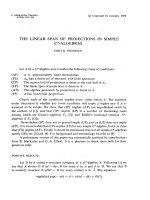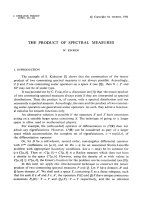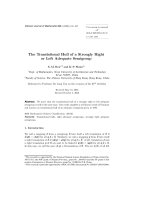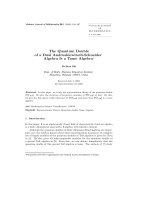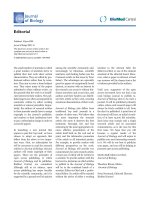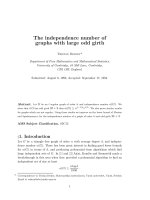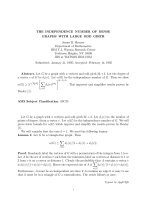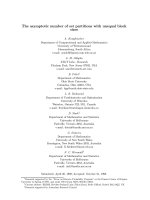Báo cáo toán học: "The maximum number of perfect matchings in graphs with a given degree sequence" docx
Bạn đang xem bản rút gọn của tài liệu. Xem và tải ngay bản đầy đủ của tài liệu tại đây (70.07 KB, 2 trang )
The maximum number of perfect matchings
in graphs with a given degree sequence
Noga Alon
∗
Shmuel Friedland
†‡
Submitted: Mar 19, 2008; Accepted: Apr 13, 2008; Published: Apr 24, 2008
Abstract
We show that the number of perfect matchings in a simple graph G with an even
number of vertices and degree sequence d
1
, d
2
, . . . , d
n
is at most
n
i=1
(d
i
!)
1
2d
i
. This
bound is sharp if and only if G is a union of complete balanced bipartite graphs.
2000 Mathematics Subject Classification: 05A15, 05C70.
Keywords and phrases: Perfect matchings, permanents.
1 Introduction
Let G = (V, E) be an undirected simple graph. For a vertex v ∈ V , let deg v denote
its degree. Assume that |V | is even, and let perfmat G denote the number of perfect
matchings in G. The main result of this short note is:
Theorem 1.1
perfmat G ≤
v∈V
((deg v)!)
1
2 deg v
, (1.1)
where 0
1
0
= 0. If G has no isolated vertices then equality holds if and only if G is a disjoint
union of complete balanced bipartite graphs.
For bipartite graphs the above inequality follows from the Bregman-Minc Inequality
for permanents of (0, 1) matrices, mentioned below.
The inequality (1.1) was known to Kahn and Lov´asz, c.f. [2, (7)], but their proof was
never published, and it was recently stated and proved independently by the second author
in [3]. Here we show that it is a simple consequence of the Bregman-Minc Inequality.
∗
School of Mathematics, Tel Aviv University, Ramat Aviv, Tel Aviv 69978, Israel, and IAS, Prince-
ton, NJ 08540, USA, e-mail: Research supported in part by the Israel Science
Foundation and by a USA-Israeli BSF grant.
†
Department of Mathematics, Statistics, and Computer Science, University of Illinois at Chicago,
Chicago, Illinois 60607-7045, USA, e-mail
‡
Visiting Professor, Fall 2007 - Winter 2008, Berlin Mathematical School, Berlin, Germany
the electronic journal of combinatorics 15 (2008), #N13 1
2 The proof
Let A be an n × n (0, 1) matrix, i.e. A = [a
ij
]
n
i,j=1
∈ {0, 1}
n×n
. Denote r
i
=
n
j=1
a
ij
, i =
1, . . . , n. The celebrated Bregman-Minc inequality, conjectured by Minc [4] and proved
by Bregman [1], states
perm A ≤
n
i=1
(r
i
!)
1
r
i
, (2.1)
where equality holds (if no r
i
is zero) iff up to permutation of rows and columns A is a
block diagonal matrix in which each block is a square all-1 matrix.
Proof of Theorem 1.1: The square of the number of perfect matchings of G counts
ordered pairs of such matchings. We claim that this is the number of spanning 2-regular
subgraphs H of G consisting of even cycles (including cycles of length 2 which are the
same edge taken twice), where each such H is counted 2
s
times, with s being the number
of components (that is, cycles) of H with more than 2 vertices. Indeed, every union of a
pair of perfect matchings M
1
, M
2
is a 2-regular spanning subgraph H as above, and for
every cycle of length exceeding 2 in H there are two ways to decide which edges came
from M
1
and which from M
2
.
The permanent of the adjacency matrix A of G also counts the number of spanning
2-regular subgraphs H
of G, where now we allow odd cycles and cycles of length 2 as
well. Here, too, each such H
is counted 2
s
times, where s is the number of cycles of H
with more than 2 vertices, (as there are 2 ways to orient each such cycle as a directed
cycle and get a contribution to the permanent). Thus the square of the number of perfect
matchings is at most the permanent of the adjacency matrix, and the desired inequality
follows from Bregman-Minc by taking the square root of (2.1), where the numbers r
i
are
the degrees of the vertices of G.
It is clear that if G is a vertex-disjoint union of balanced complete bipartite graphs
then equality holds in (1.1). Conversely, if G has no isolated vertices and equality holds,
then equality holds in (2.1), and no r
i
is zero. Therefore, after permuting the rows and
columns of the adjacency matrix of G it is a block diagonal matrix in which every block
is an all-1 square matrix, and as our graph G has no loops, this means that it is a union
of complete balanced bipartite graphs, completing the proof. ✷
References
[1] L.M. Bregman, Some properties of nonnegative matrices and their permanents, Soviet
Math. Dokl. 14 (1973), 945-949.
[2] B. Cuckler and J. Kahn, Entropy bounds for perfect matchings and Hamiltonian
cycles, to appear.
[3] S. Friedland, An upper bound for the number of perfect matchings in graphs, arXiv:
0803.0864v1, 6 March 2008.
[4] H. Minc, Upper bounds for permanents of (0, 1)-matrices, Bull. Amer. Math. Soc. 69
(1963), 789-791.
the electronic journal of combinatorics 15 (2008), #N13 2

